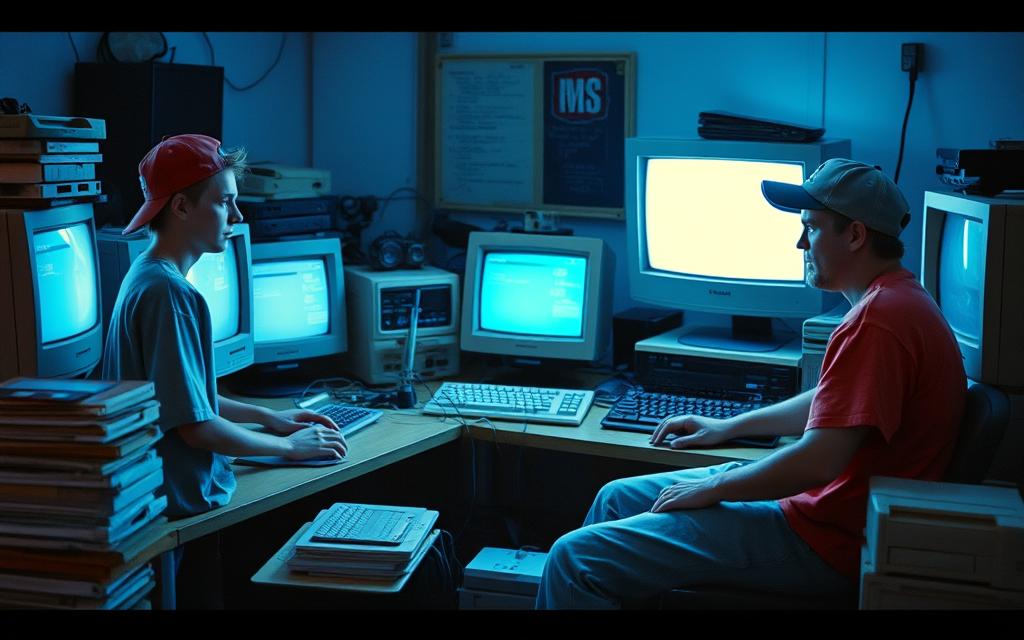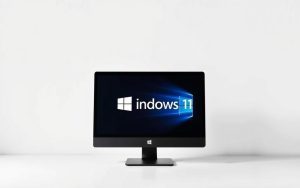Table of Contents
The 1990s marked a turning point for technology. Visionaries like Bill Gates and Paul Allen laid the foundation for modern computing. Their work reshaped how the world interacts with machines.
Back then, tech enthusiasts faced stereotypes. Many dismissed them as outcasts. Yet, their passion fueled innovations that changed history.
Windows 95’s launch symbolized a cultural shift. What started in garages evolved into billion-dollar empires. The era transformed ridicule into admiration for technical brilliance.
This article explores how early pioneers shaped today’s digital landscape. From clunky desktops to sleek devices, their legacy endures.
The Rise of the 90s Computer Nerd
Tech culture in the 1990s wasn’t just about gadgets; it was a way of life. Douglas Adams famously defined it: “A nerd uses technology to talk about technology.” This mantra captured the era’s obsession with innovation and problem-solving.
Defining the “Nerd” in the Digital Age
Early adopters formed tight-knit groups, often dismissed as outsiders. Stereotypes painted them as socially awkward—think thick glasses and pocket protectors. Yet, places like Weird Stuff Warehouse became hubs for collaboration.
Coding languages like COBOL and BASIC created high barriers to entry. Mastering them required patience, turning programming into a badge of honor. For many, it was less about fitting in and more about pushing boundaries.
How Early Tech Culture Shaped Identity
Startup culture thrived on caffeine and camaraderie. Microsoft’s “any 80 hours per week” philosophy, fueled by pizza and soda, became legendary. Beanbag chairs and all-nighters symbolized dedication.
Garage projects turned into global business empires. What began as hobbyist tinkering reshaped entire industries. The 1990s proved that passion could redefine culture—one line of code at a time.
Were There Computer Nerds in the 90s? Absolutely
Garage workshops birthed empires that dominate tech today. What began as tinkering evolved into global companies, reshaping how we live. The 1990s proved that passion could turn soldering irons into fortunes.
Key Figures Who Embodied the Label
Paul Allen epitomized the era’s duality. After co-founding Microsoft in a cramped room, he bought the Portland Trail Blazers. His journey mirrored the shift from outsider to icon.
The Altair 8800 symbolized raw innovation. With no keyboard or monitor ports, it demanded patience. Yet, enthusiasts camped outside MITS for kits. “They treated it like concert tickets,” recalled David Bunnell.
From Garages to Global Influence
Steve Jobs and Steve Wozniak expected a fun project—not Apple’s historic IPO. Their work captured a hungry market. By 1975, MITS projected 800-unit sales but received 250 daily orders.
This stuff wasn’t just hardware; it was cultural rebellion. Early adopters thrived on switches and code, laying groundwork for today’s tech titans. The kind of dedication shown in those cluttered spaces changed history.
The Stereotypes vs. Reality
Media stereotypes clashed with the real stories of Silicon Valley pioneers. While television scripts leaned into squeaky voices and pocket protectors, visionaries like Steve Jobs were building empires. This decade’s true innovators defied every trope.
Thick Glasses and Pocket Protectors: Media Portrayals
90s movies exaggerated quirks, reducing genius to awkward caricatures. Characters like Screech and Urkel became shorthand for tech passion. Yet, behind the screen, Jobs celebrated a $1B net worth by 1996.
The ‘loner’ type was a myth. PARC researcher Larry Tesler embodied the *”changing the world”* ethos. Bill Atkinson’s Mac development stories further shattered the detached nerd stereotype.
How Nerds Defied Expectations
Hand-built prototypes and late-night coding sessions fueled progress. Christine Comaford’s passion for databases highlighted a gender gap—yet proved women thrived in tech. Real-life stories outpaced fiction.
From garage tinkering to IPO glory, the 1990s rewrote the script. What television mocked, Silicon Valley monetized. The era’s legacy? Brilliance transcends stereotypes.
Tech Innovations Fueled by Nerds
Revolutionary leaps in computing defined an era of boundless creativity. Passionate minds transformed vacuum tubes into microprocessors, reshaping what machines could achieve. The Intel 8080 chip became accidental royalty, powering devices despite its $10,000 price tag.
The Birth of Personal Computing
Early machines demanded extreme patience. Programming the Altair required flipping 900 switches for a 100-byte program. Steve Wozniak famously treated PDP-8 manuals like scripture, later applying those lessons to Apple’s designs.
Xerox PARC’s graphical interface prototype sparked Jobs’ Macintosh vision. This shift from command lines to icons made technology accessible. What began as niche tinkering became household essentials.
Software Breakthroughs and Late-Night Coding
Grace Hopper’s COBOL development proved programming could solve real-world problems. ENIAC’s 20-second artillery calculations showed raw potential. Key milestones shaped modern coding:
- FORTRAN (1957) – First high-level language
- BASIC (1964) – Democratized programming
- C (1972) – Foundation for operating systems
Dark rooms lit by CRT screens became innovation hubs. “We lived on caffeine and stubbornness,” recalled early Microsoft engineers. Their night-long sessions built tools we still use today.
Silicon Valley’s Nerd Culture
Innovation in the 1990s wasn’t confined to offices—it spilled into garages and beanbag-filled rooms. Visionaries rejected corporate norms, favoring spaces that sparked creativity. This culture blended equality with relentless ambition.
From Beanbag Chairs to Billion-Dollar Ideas
Xerox PARC’s beanbag brainstorming sessions became legendary. Researchers like Bob Metcalfe developed Ethernet here, later reaching 50 million users. “We shared information freely,” he recalled. The space encouraged collaboration over hierarchy.
Contrast this with Steve Jobs’ NeXT cube office. Sleek and minimalist, it reflected his design obsession. Yet both environments shared one trait: they prioritized ideas over appearances.
| Workspace | Key Feature | Legacy |
|---|---|---|
| Xerox PARC | Beanbag chairs, open floor plan | GUI, Ethernet, laser printing |
| NeXT Office | White walls, isolated work cubes | NeXTSTEP OS (basis for macOS/iOS) |
Why Garages Became Legendary
HP’s 1938 garage startup set the tone. Microsoft and Apple followed, turning cramped spaces into tech empires. Garages symbolized resourcefulness—a rejection of traditional business models.
Gordon Moore’s Intel took it further. His “no reserved parking” policy flattened hierarchies. Early teams thrived in hacker houses, like Architext’s spaghetti-container office humor. Of course, not all succeeded. But those who did changed the market forever.
The Tools of the Trade
Clunky hardware and slow connections defined the 90s tech experience. This era relied on physical media and noisy modems—everyday stuff that now seems ancient. Yet these tools built foundations for today’s digital world.
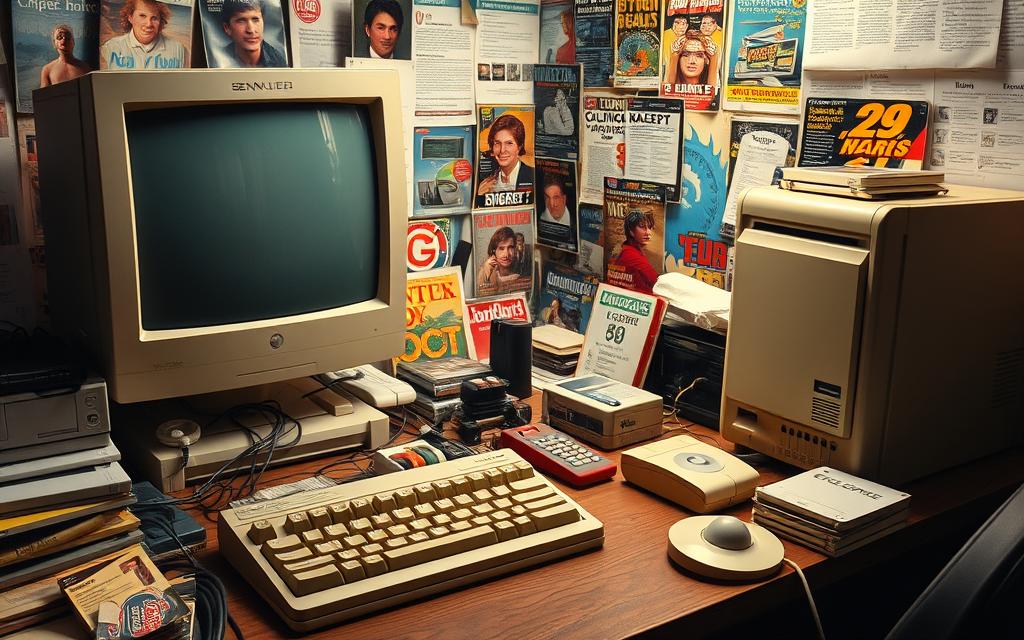
Floppy Disks, Dial-Up, and Early Internet
1.44MB floppies stored barely a photo by modern standards. BBS systems thrived in server rooms, creating pre-web communities. Users traded files and messages at glacial speeds.
Dial-up services battled for dominance:
| Service | Speed | Cost |
|---|---|---|
| CompuServe | 14.4kbps | $6 per day |
| AOL | 28.8kbps | Free trials (CD campaign) |
Steve Ballmer called PCs “the fabric of life”—a vision realized through killer apps. Lotus 1-2-3 spreadsheets and WordPerfect documents drove home office adoption.
Hardware That Defined the Era
Intel’s 486DX processors brought 32-bit power to desktops. Dot-matrix printers churned out school reports with distinctive perforated edges. Zip drives offered 100MB storage—a revelation after floppies.
Key gaming wars played out on flickering screens:
- Nintendo’s SNES vs. Sega Genesis
- 3DFX graphics cards enabling early 3D games
- Sound Blaster audio cards for immersive effects
These tools may seem primitive now. But they fueled innovations that reshaped work, play, and communication forever.
Nerds in Pop Culture
Hollywood’s portrayal of tech enthusiasts often missed the mark. While some movies captured the spirit, others leaned heavily into outdated tropes. This decade saw both cringe-worthy stereotypes and surprising moments of authenticity.
Movies and TV Shows That Got It (Mostly) Wrong
Revenge of the Nerds (1984) amplified every cliché—thick glasses, social awkwardness, and pocket protectors. Yet Real Genius (1985) showed a different way, with Val Kilmer’s character balancing brilliance with charm.
The X-Files created an unexpected ripple effect. Dana Scully’s forensic science background inspired a 63% spike in women pursuing STEM fields. “She made intelligence look cool,” noted a 1999 MIT study.
Screech, Urkel, and Other Caricatures
Steve Urkel started as a joke on Family Matters. By the end, his “Juicebox” experiments hinted at real innovation. The character’s evolution mirrored changing attitudes.
Star Wars fans showed deeper engagement than television writers expected. The 1997 “Han shot first” debate proved audiences cared about technical details. Passionate discussions filled early internet forums.
Female characters faced unique challenges. Lara Croft’s design prioritized sexuality over substance. Modern heroes like Furiosa and Jessica Jones now showcase complexity—a shift begun by 90s trailblazers.
The Gender Gap in 90s Tech
Gender disparities shaped the 1990s tech landscape in ways still felt today. While visionaries like Grace Hopper laid foundations decades prior, cultural shifts created new barriers. By 1995, women earned just 17% of computer science degrees—down from 37% in 1984.
Hidden Figures of the Digital Revolution
Adele Goldberg fought to keep Xerox PARC’s graphical interface from Apple. Her team’s groundbreaking work powered the Macintosh, yet few knew their names. “We were building the future, not our resumes,” she later reflected.
Christine Comaford championed database tech when few women led engineering teams. Her passion defied stereotypes: “Data solves real-world problems better than any boardroom argument.” Such pioneers thrived despite systemic challenges.
Breaking the Silicon Ceiling
Corporate cultures slowly evolved. Steve Ballmer declared Windows 95 should work for “even my mother”—a nod to accessibility. Meanwhile, gaming saw breakthroughs:
- Roberta Williams co-founded Sierra On-Line, creating iconic adventure games
- Women comprised 38% of game developers by 1999 (ESA data)
- Educational toys still segregated pink “creative” sets from blue “tech” kits
These contradictions defined an era. Grace Hopper’s COBOL legacy proved women shaped computing history. Yet store aisles suggested technical work wasn’t for everyone. The 1990s became both a warning and roadmap for fixing tech’s diversity problem.
From Ridicule to Respect
Attitudes toward technical brilliance shifted dramatically during the late 20th century. The Netscape IPO of 1995 marked a pivotal moment, transforming coding skills into potential goldmines. Suddenly, garage developers became Wall Street darlings overnight.
How Technical Passion Gained Social Currency
Linux’s open-source movement rebelled against corporate culture while gaining mainstream credibility. “It wasn’t about money—it was about changing the world,” noted early contributor Eric Raymond. This anti-establishment ethos made programming seem revolutionary rather than eccentric.
Apple’s Think Different campaign strategically aligned tech with counterculture rebels. By featuring Einstein and Picasso, they rebranded technical minds as visionary artists. The campaign’s success proved intellectualism could be marketed as cool.
The Fashion of Intellectualism
Mark Zuckerberg’s hoodie billionaire image replaced outdated pocket protector jokes. Silicon Valley’s casual dress code became aspirational, signaling that ideas mattered more than appearances. Douglas Adams observed this shift: “Nerds stopped being a kind of outsider—they became the culture itself.”
Key factors driving this transformation:
- Dot-com millionaires proving technical skills could create wealth
- Tech companies fostering creative workspaces with relaxed dress codes
- Mainstream media celebrating innovators rather than mocking them
Bill Gates’ 1995 celebrity status symbolized this change. His Microsoft empire demonstrated how technical expertise could reshape global business. Within years, the same traits once ridiculed became respected worldwide.
Nerds and the Internet Revolution
A screeching 56k modem became the anthem of a digital awakening. Passionate pioneers built communities pixel by pixel, long before algorithms dictated content. This era birthed memes, forums, and a DIY ethos that still shapes online culture.
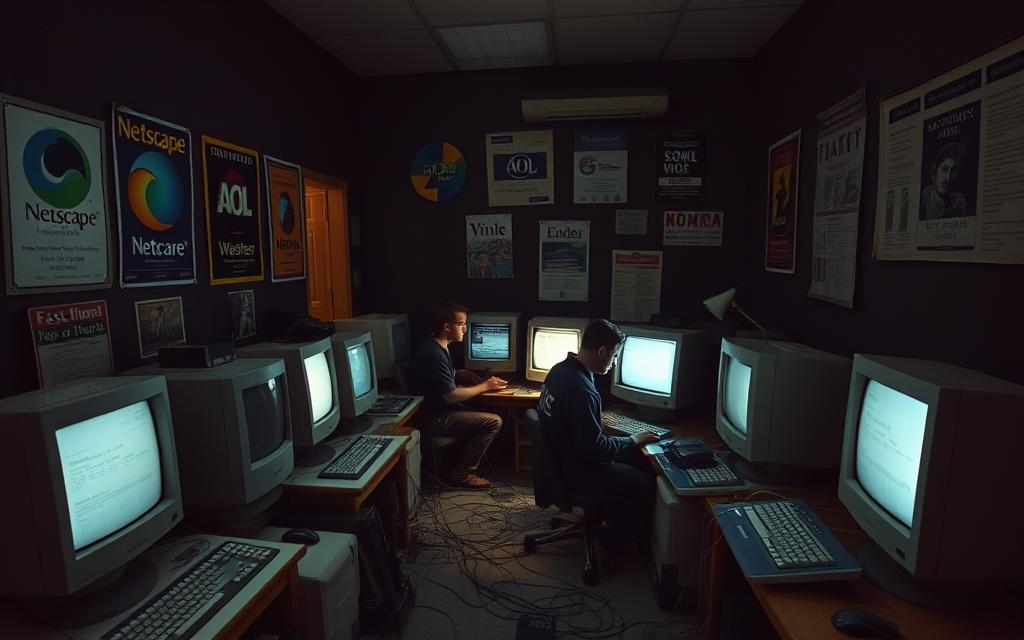
Early Adopters of the Digital Frontier
Usenet groups functioned like exclusive clubs. Hierarchies like alt.* and comp.* organized discussions—a precursor to modern subreddits. Unlike today’s platforms, these spaces lacked moderation but thrived on shared curiosity.
John Perry Barlow’s 1996 Declaration of Cyberspace Independence captured the spirit: “Governments derive their powers from the consent of the governed. You have neither solicited nor received ours.” This idealism fueled early web experiments.
| Feature | Usenet (1990s) | Reddit (Today) |
|---|---|---|
| Structure | Text-based hierarchies | Subreddits with multimedia |
| Moderation | Community-driven | Algorithm + human oversight |
| Speed | Days for replies | Real-time interactions |
Chat Rooms, Fan Sites, and the First Memes
GeoCities turned hobbies into digital neighborhoods. Fans coded HTML by hand, creating shrines to bands or TV shows. Web rings linked these pages—organic discovery before search engines dominated.
Early memes spread via email chains and forums:
- Hampster Dance: A looping GIF with a catchy MIDI tune
- Dancing Baby: 3D-rendered viral sensation
- All Your Base: Poorly translated game text turned cult phrase
These artifacts remind us how far we’ve come. What began as late-night tinkering evolved into the connected world we navigate today.
The Hobbyist Mentality
Tinkering wasn’t just a pastime—it was the foundation of digital revolutions. Before Silicon Valley glamorized startups, visionaries like Steve Wozniak built Blue Boxes for fun. These passion projects often became profitable ventures, reshaping entire industries.
Tinkering as a Way of Life
Linus Torvalds’ 1991 Linux kernel post began with humble curiosity. “Just a hobby,” he wrote, unaware it would power servers worldwide. Similarly, id Software’s shareware model proved small experiments could disrupt business norms.
BBS communities fueled debates on software piracy. Yet, they also incubated innovations. Apogee Entertainment’s $20k Doom success showed indie potential long before today’s app stores.
How Passion Projects Became Profitable
Steve Jobs famously connected calligraphy to Mac’s typography. “You can’t connect the dots looking forward,” he said. This ethos defined the era—hobbies like soldering or coding often led to market breakthroughs.
RadioShack components empowered early builders. Now, Raspberry Pi kits continue that legacy. What began as basement experiments evolved into global enterprises, proving passion transcends stuff like money or trends.
Nerds vs. Geeks: The 90s Debate
Labels divided enthusiasts long before algorithms categorized content. Technical mastery and pop culture fandom sparked endless identity wars. These distinctions felt vital—until they didn’t.
Subtle Differences That Mattered
Comdex attendees wore suits while Comic-Con fans sported capes. This visual split mirrored deeper divides. Geeks obsessed over Star Trek lore; nerds debugged Linux kernels before breakfast.
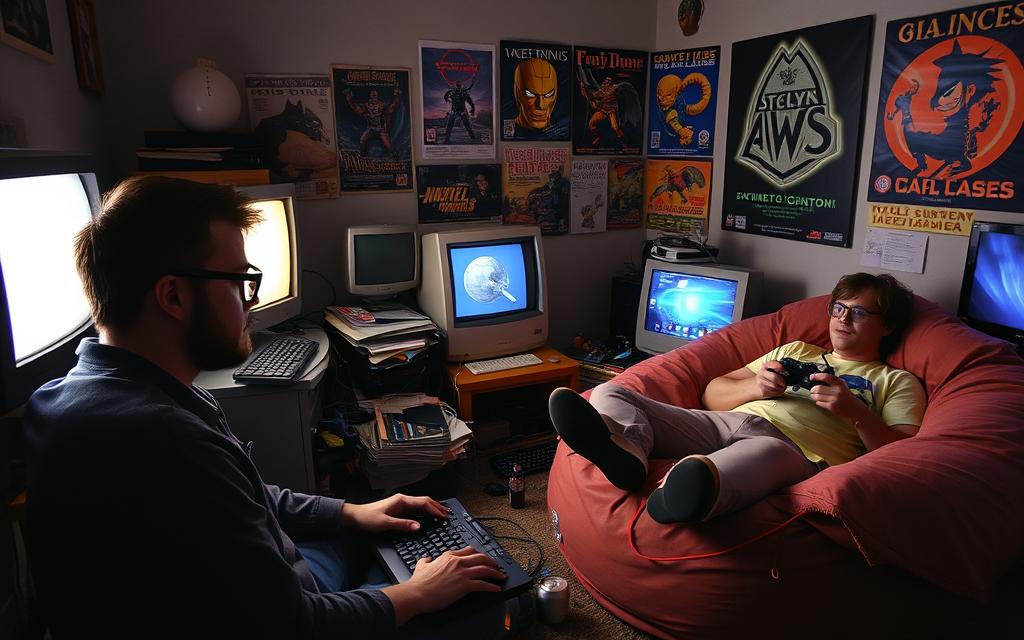
“Nerds solve problems. Geeks collect knowledge.”
Slashdot’s 1997 launch cemented this hierarchy—technical skill trumped all.
Why Labels Started to Fade
Dot-com wealth blurred old boundaries. Suddenly, Python scripts paid for concert tickets. By 2007, The Big Bang Theory rebranded “geek” as mainstream—though critics argued it revived stereotypes.
Key shifts erased the divide:
- Open-source collaborations valued diverse skills
- Tech billionaires became pop culture icons
- Online forums mixed trivia with troubleshooting
Today, the words barely register as insults. What took years to build dissolved faster than a dial-up connection.
The Legacy of 90s Nerds
Few predicted how garage tinkering would redefine modern business. What began as soldering experiments evolved into a $120B PC industry within 20 years. The 1995 Netscape IPO—valued at $2.9B—proved technology could rival Wall Street giants.
How They Paved the Way for Modern Tech
Larry Page and Sergey Brin’s 1996 Stanford research birthed Google. Their algorithm transformed how the world accesses information. Similarly, Apache (1995) and PHP (1994) laid groundwork for today’s web infrastructure.
Steve Ballmer’s infamous “developers, developers, developers!” chant foreshadowed app ecosystems. Open-source collaboration became the backbone of innovation. Projects like Linux proved communal effort could outpace corporate R&D.
From Outsiders to Industry Titans
Jeff Bezos launched Amazon from a Seattle garage. His vision redefined retail, proving tech startups could dominate traditional markets. The Y2K panic further cemented society’s reliance on digital solutions.
Key milestones:
- Netscape’s IPO: First major tech valuation surge
- Google’s PageRank: Revolutionized search algorithms
- Open-source boom: Democratized software development
“The 90s taught us that code could build empires.”
This era’s legacy? Every major company today stands on the shoulders of those dismissed as outsiders. Their passion shaped the digital world we navigate now.
What Today’s Nerds Can Learn
Limitations often spark the most creative solutions—a truth proven by 90s tech pioneers. Their resourceful approaches built foundations for our digital world. Modern creators can gain valuable insights from this era’s hands-on mentality.

The DIY Ethos That Changed Everything
Steve Wozniak captured the spirit best: “We did it for fun…not knowing it’d go far.” This attitude fueled breakthroughs from ANSI art to shareware games. Constraints bred innovation where modern comforts might stifle it.
Early teams embraced the “worse is better” philosophy. Perfect code mattered less than working prototypes. Architext’s spaghetti-container office humor showed how makeshift spaces fostered creativity.
| 1990s Approach | Modern Equivalent | Key Difference |
|---|---|---|
| Hand-soldered circuits | Raspberry Pi kits | Accessibility vs. understanding |
| BBS file sharing | Cloud collaboration | Local vs. global scale |
| Garage startups | VC-funded incubators | Passion vs. profit focus |
Why That Era Still Matters
Retrocomputing trends reveal enduring lessons. Arduino and Raspberry Pi movements echo 90s tinkering. Yet venture capital culture risks eroding that garage-built spirit.
The demo scene proved artistic coding could thrive within technical limits. Modern developers might rediscover this balance. Sometimes fewer tools yield sharper skills.
“Great things come from humble beginnings—if you care more about solving problems than looking cool.”
Those early years shaped how we interact with technology today. The best innovations often start as simple solutions to everyday things.
Conclusion
What critics mocked became the blueprint for modern innovation. The past decade’s tinkerers built a $3T tech industry from garages and late-night coding sessions.
Compare 1995’s Windows 95 frenzy to today’s SaaS ecosystems. Both prove how simple things reshape daily life. Steve Jobs’ “dent in the universe” ethos still drives visionaries.
Who are today’s equivalents—those building the next digital world in basements? As Edwin Chin noted in 1996: “Can’t let others stop your dreams.” The best ideas often start where people least expect them.
FAQ
What defined a "nerd" in the ’90s tech scene?
Passion for early personal computing, deep knowledge of hardware or software, and often a hobbyist mindset set them apart. Many embraced the label despite stereotypes.
Did pop culture accurately portray ’90s computer enthusiasts?
Shows like Saved by the Bell exaggerated traits, but real innovators like Steve Wozniak proved tech passion drove progress more than clichés.
How did garage startups shape Silicon Valley?
Companies like Apple and Amazon began with tinkering. Low-cost experimentation allowed breakthroughs that corporate labs often missed.
What tech tools were essential for ’90s nerds?
Dial-up modems, floppy disks, and early programming languages like BASIC enabled the first wave of digital creativity before broadband changed everything.
Why did "geek chic" emerge by the decade’s end?
As the internet boomed, technical skills gained value. Bill Gates and others transformed the nerd image from outsider to aspirational.
Were women visible in ’90s nerd culture?
A> Figures like Marissa Mayer at Google broke barriers, but gender gaps persisted. Early online communities often marginalised female voices in tech.
How did early internet culture reflect nerd values?
Bulletin boards and fan sites rewarded knowledge-sharing. This collaborative spirit laid groundwork for open-source movements today.


